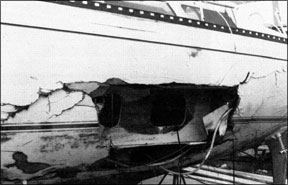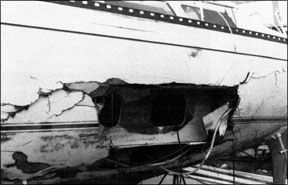Chasing Deck Leaks
Our Islander 36 has a padded vinyl headliner. Leaks are very difficult to locate. The boatyard has pumped air into the boat in an effort to locate problem areas, but this has not been successful. Can you advise on a method to locate leaks?
The problem with any type of headliner is that it can disguise the origin of leaks. Water may travel many feet behind the headliner before it finds an exit point.
If removing the headliner is impractical, you’ll have to begin your detective work from the outside. Any place the deck is pierced by a mounting bolt, hatch, window, mast opening, electrical outlet, or the like, is a potential source of leaks. Assume that if the deck leaks with the boat at rest, the source of the leak will be uphill from the place water appears on the inside of the boat.

288
If the leak is nothing more than an occasional drip when you have a downpour, its source is not likely to be apparent from an external examination of things attached to the deck. If it’s a major leak, there should be external evidence in the form of voids in bedding compound around hardware, a gap under a handrail, etc.
The usual method for tracing difficult leaks is to play a high pressure hose on the suspected source, then see if the leak appears on the inside in its usual fashion. Obviously, it takes two people to trace leaks this way.
Leaks are most common around hardware that is frequently or heavily stressed, such as turning blocks or lifeline stanchion bases. Often, the leaks are aggravated by inadequate backing plates which allow excessive local flexing of the deck, breaking the bond between the bedding compound and the object bedded.
Even if you are able to isolate a leak with the high pressure hose technique, you may have to remove the headliner to get at the offending area. It is unfortunate that sorne boats have the headliner installed after all the deck hardware is attached, making rebedding a major chore.
Painting Non-skid
The deck of our custom racer has a non-skid finish which is a rolled-on gelcoat. It’s not very pretty, but it’s the most effective non-abrasive nonskid surface we have ever encountered. Unfortunately, like all gelcoat it is slightly porous, and has become stained and dirty looking. No amount of washing will help.
As a result, this spring we intend to paint the deck, using a very light coat of two-part epoxy paint.
The boatyard recommended the following preparation, and we would like your comments on it:
1) use a dewaxer;
2) clean surface with acetone;
3) use two-part epoxy paint with as much thinner as you want, so the paint just covers the stains.
Does this sound right to you? If not, do you have any other suggestions? By the way, we are not afraid of reducing the non-skid properties of the deck at all – it’s really overkill right now.
Your boatyard’s suggestions make sense, but we would modify them slightly, particularly concerning the paint to be used. The epoxy paints with which we’ve had experience have really been little better than conventional alkyd paints in terms of longevity and resistance to chalking.
Instead, we’d use a two-part brushable polyurethane, applied with a smooth roller. Polyurethane paints are already. quite thin, so you won’t have to thin the paint.
However, their ability to cover stains is quite poor. I assume that you have fairly light decks that have dark stains on them. You may well find that it is necessary to spot-prime badly stained areas in order to get adequate coverage with one coat of finish paint. We’d use epoxy primer for spot priming.
Surface preparation should consist of thorough scrubbing with powdered soap or abrasive cleanser using a brush, followed by a very thorough rinse with fresh water. When that is dry, wash down with International (Interlux) 202 Solvent Wash, or another de-waxer.
Spot prime as needed. Do it again if the first coat doesn’t cover, because the finish paint won’t cover anything.
Since this will take several days, cover the boat overnight to keep the decks dry.








































